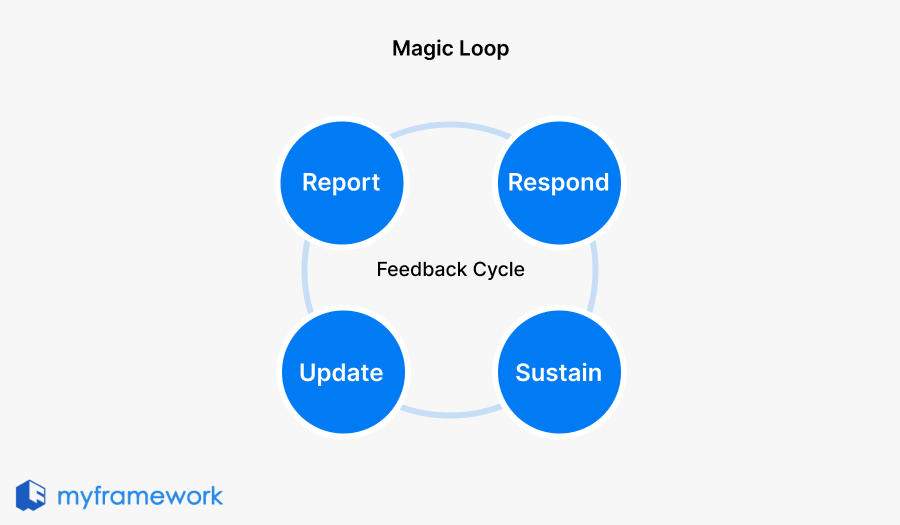Many teams struggle with broken feedback loops, where insights get stuck, action is delayed, and users or stakeholders feel unheard. These gaps weaken trust, lower engagement, and stall progress.
Magic Loop, a practical, cyclical communication framework designed to close the feedback loop efficiently and transparently. While its exact origin isn’t tied to a single creator, the model has been increasingly adopted in tech, service design, and product teams to enhance continuous learning and customer responsiveness.
Core Concept: What Is the Magic Loop?
The Magic Loop consists of four essential stages.

Report
Capture and share what has been observed — be it a bug, user feedback, performance insight, or operational issue. The goal is to ensure the problem or input is clearly logged and acknowledged.
- Use accessible channels (support tickets, surveys, retrospectives).
- Structure the report: What happened? Who’s affected? What’s the evidence?
Respond
Take timely action.
This doesn’t always mean solving the issue immediately but showing that the input has been heard and addressed. Just remember, feeling some time is much more important than the result.
- Acknowledge receipt and give an expected timeline.
- Prioritize and route to the right owner.
- Respond with empathy and clarity.
Sustain
Sustain is about ensuring that the solution or change is working and can be maintained over time.
- Introduce monitoring or documentation to lock in the change.
- Train teams or update procedures to prevent backsliding.
- Reinforce the impact of improvements.
A quick tip here: Don’t announce the fix until you’re sure it sticks. Let me give you an example:
- A bug is fixed — great.
- But to Sustain, you make sure it’s tested, won’t regress, and is supported by systems or policies.
With all the concrate inputs, then we can move to the next and final stage: Update.
Update
Close the loop with the original reporter or broader community. Let them know what was done, what changed, or why it couldn’t be implemented (and what’s next).
- Share outcomes (even partial wins).
- Communicate clearly, even if the result isn’t perfect.
- Build trust by being transparent and consistent.
It’s called a “loop” for a reason — the process is ongoing and should repeat as new feedback or issues emerge.
Unlock all frameworks and templates
Unlock exclusive thinking frameworks and practice templates.
Become a member to access all premium content to elevate your thinking!
When to Use the Magic Loop
Here are a few real-world examples:
Product Development
A beta user reports a UI bug → Product team logs it (Report), acknowledges and fixes it (Respond), builds automated tests to prevent recurrence (Sustain), and informs the user through release notes (Update).
Customer Support
A user suggests a missing feature → Support logs the request (Report), Product team reviews and gives feedback on feasibility (Respond), decision is added to roadmap (Sustain), and updates are shared via newsletters or changelogs (Update).
Internal Team Retrospectives
Team highlights inefficient meetings → Scrum master logs concern (Report), leadership pilots new format (Respond), adopts it if successful (Sustain), and shares results at the next team check-in (Update).
Tips to Make the Magic Loop Work
- Don’t skip the “Update” stage — it’s often neglected, yet it’s where trust is built.
- Visualize the loop: Create dashboards or reports that show where each piece of feedback is in the cycle.
- Encourage feedback culture: The more transparent and consistent the loop, the more likely people are to share meaningful insights.



